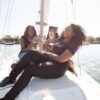One of the most important pieces of equipment on a boat is a VHF marine radio. Boaters who plan on going more than a few miles from shore should also have an MF/HF radiotelephone and an emergency position indicating a radio beacon (EPIRB). Note: The FCC requires a Ship Station License for boats with a single side-band MF/HF radiotelephone unless they are small recreational vessels. Types of VHF Radios There are two main types of VHF radios — rechargeable hand-held radios and fixed-mounted radios. Fixed mounted radios have an antenna mounted to the boat that’s capable of transmitting greater distances. In general, VHF marine radios have a range of about 5-10 miles and at least 20 miles to a USCG station. Tune In to the Radio Channels The FCC requires that any boat equipped with a VHF marine radio keep a watch on channel 16 (156.800 MHz) whenever the radio isn’t being used to communicate. Channel 16 is recognized worldwide as the distress, safety, and calling channel, and is used by the USCG to make urgent broadcasts and weather warnings. Though you may occasionally switch to channel 9 to communicate with other recreational boats, you are likely to make contact with them on channel 16 first. Channel 16: The international distress, safety, and calling channel is constantly monitored by the USCG. Use it to contact them or nearby boats in the event of an emergency. You can also use it to contact commercial shipping vessels and to hail recreational vessels, however, additional communication should be moved to another channel. Channel 9: The national boater calling channel allows for non-commercial boats and shore units to communicate, and can be useful when channel 16 is congested. Turn on your VHF radio and adjust the squelch dial until you hear static from the speaker, then adjust the volume. Re-tune the squelch dial to get a clear reception. How to Perform a Radio Check Make sure your radio is working properly and that others can hear you by doing a radio check. Tune to an open channel, like 71, and hold the microphone at a 90-degree angle to your face, speaking clearly. Say “radio check” three times, then the name of your boat. For example: “Radio check, radio check, radio check, Starfish.” You should get a response like “loud and clear Starfish,” or “five by five,” indicating a strong signal. Do not ever call a false mayday to get a response to your radio check. Every mayday hoax is subject to prosecution as a Class D felony, liable for a $5,000 fine, plus all costs the Coast Guard incurs responding to it. The Coast Guard and FCC can use special technologies to identify your radio. Mayday: The International Distress Signal The word mayday is the international distress signal. If your boat is in trouble and you need emergency assistance, follow these steps to send a distress call. Tune to channel 16 and speak the word mayday three times. Say, “This is [name your boat three times].” Say your call sign or boat registration number once. Repeat “mayday” and the name of your vessel once. Give your position by latitude or longitude or bearing (true or magnetic — specify which), and your distance from a well-known landmark, such as a navigational aid, lighthouse or island. Describe what you think would best help a responding station locate your boat. Include information on your vessel’s movement, such as speed, course, and destination, if possible. State the nature of your distress — fire, sinking, etc. Communicate what kind of assistance you need. Give any other information that will help rescue efforts, such as the size of your vessel, hull color, the number of people injured, etc. Say “over” when you are done speaking. Here is a sample script, from the USCG, of the above information: MAYDAY-MAYDAY-MAYDAY?THIS IS BLUE DUCK-BLUE DUCK-BLUE DUCK WA1234 MAYDAY THIS IS BLUE DUCK?CAPE HENRY LIGHT BEARS 185 DEGREES MAGNETIC-DISTANCE 2 MILES?STRUCK SUBMERGED OBJECT?NEED PUMPS-MEDICAL ASSISTANCE AND TOW?THREE ADULTS, TWO CHILDREN ONBOARD?ONE PERSON COMPOUND FRACTURE OF ARM?ESTIMATE CAN REMAIN AFLOAT TWO HOURS?BLUE DUCK IS THIRTY TWO FOOT CABIN CRUISER-WHITE HULL-BLUE DECK HOUSE?OVER Repeat the call until there is a response, and keep close to the radio if you can. The Coast Guard may need you to transmit a signal for a rescue boat or aircraft to home in on. Note: If you hear an unanswered distress call from another vessel, then it is your responsibility to answer it. If you think it is too far away, then give other boats the opportunity to respond first. Pan-pan Indicates an Emergency On Board Pan-pan is used to signal an emergency aboard a vessel and indicates that the safety, but not the life, of a person on board is at risk. It may be used when a person has fallen overboard. Pan-pan differs from mayday in that it does not indicate that the vessel itself is in danger. It is transmitted on channel 16 has priority over all communication on the airwaves except for a mayday. The Least Urgent Call: Sécurité Sécurité is used to relay important safety information such as navigational and meteorological warnings that are not necessarily life-threatening. It is broadcast over channel 16 and then on channel 22A. Sécurité is the least urgent call, after Mayday and Pan-pan. How to Hail Another Vessel You can use channel 16 to hail other ships, but keep your communication short and sweet. Repeat the boat’s name you wish to contact three times, then say your boat’s name, then “over.” For example: “Astraeus Astraeus Astraeus, this is Pink Champagne, over.” At that point, the responding ship, in this case, Astraeus, might say something like “Pink Champagne this is Astraeus. Reply 68.” That means to turn to channel 68 to continue the conversation. Talking Points Make sure that your voice and that others can be heard on the airwaves. Wait until the radio is silent before attempting to speak. On VHF radios, the strongest signal is dominant, and if you aren’t








